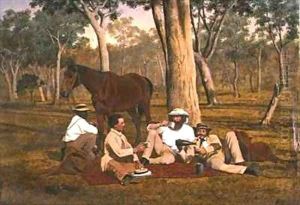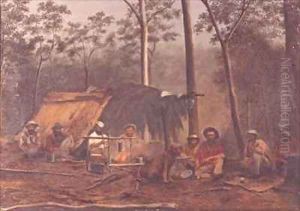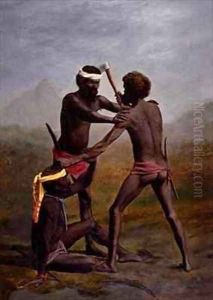Richard Daintree Paintings
Richard Daintree was a geologist and pioneer photographer born on December 13, 1832, in Hemingford Abbots, Huntingdonshire, England. Although he is not primarily known for his artistic contributions, Daintree made significant strides in the early application of photography to geology and played a notable role in the documentation of Australian landscapes and life during the mid-19th century.
Daintree's early education took place at Bedford School, and he subsequently studied geology at the Royal School of Mines in London, where he was a pupil of the famous geologist Sir Roderick Murchison. In 1852, Daintree moved to Victoria, Australia, attracted by the gold rush. He initially tried his hand at gold mining but soon returned to his scientific interests, integrating his geological work with photography.
He travelled extensively through the Victorian goldfields and, later, in the northern regions of Queensland. His geological work was groundbreaking, and he is credited with discovering coal deposits in the Bowen Basin, Queensland. His photographs from this period are among the earliest surviving images of the Australian landscape and provide an invaluable record of the goldfields and rural life.
Daintree's photographic work was pioneering in its use of the wet collodion process, a technique that allowed for detailed and high-quality images. He was one of the first to use this method in Australia, and his photographs were recognized for their excellence when exhibited in London at the 1862 International Exhibition.
In 1864, Daintree was appointed as the government geologist for the northern district of Queensland, and in 1868, he became the first geologist of the entire colony. During his tenure, he continued to integrate photography into his work, using it both as a documentary tool and as a means to promote immigration to Queensland. He produced a series of albums to attract settlers to the region, showcasing the land's potential for agriculture and mining.
Richard Daintree's health began to decline due to the tropical diseases he contracted while in Queensland, prompting his return to England in 1872. He continued to work for the Queensland government as an immigration agent and exhibited his photographs at the 1873 London International Exhibition, further supporting the Queensland immigration drive.
Daintree's contributions to geology and photography were significant, and his work provided a foundation for future geological exploration in Australia. He also helped to shape the early visual record of the Australian landscape, capturing its raw beauty and the spirit of its early settlers.
Sadly, Richard Daintree's career was cut short by illness, and he died on June 20, 1878, in Beckenham, Kent, England. His legacy endures through his geological discoveries and the rich visual heritage he left behind in his photographs, which continue to be a valuable resource for historians and art enthusiasts alike.


